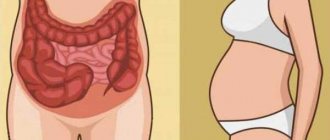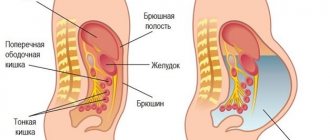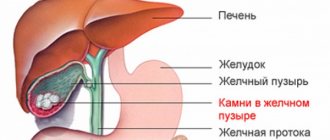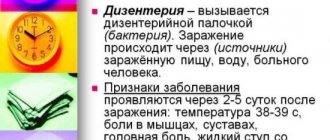Why is my stomach bloated?
Bloating in the lower abdomen causes great discomfort, which is why patients want to get rid of it as soon as possible. The following reasons can cause this condition:
- increased gas formation resulting from poor nutrition;
- dysbacteriosis;
- helminthic infestations;
- intestinal infections;
- disease of the abdominal organs, in which pain can radiate to the lower back;
- pancreatitis, in which patients will experience nausea and vomiting, as well as pain in the left side;
- intestinal obstruction;
- stomach upsets;
- weakened immune system;
- inflammatory processes in the intestines, which cause pain in the right or left lower abdomen;
- neoplasm;
- bad habits, in particular smoking;
- binge eating;
- talking while eating;
- intake of large amounts of air with food;
- dyspepsia – digestive disorder;
- food intolerance.
Poor diet can cause bloating
In women, the pathological process can be the result of the following factors: pregnancy, menstrual irregularities, menopause, endometriosis, uterine fibroids. In men, heaviness and bloating can be caused by prostatitis, the presence of kidney stones, cystitis, and diseases of the genital organs. In children, bloating is caused by overfeeding, a diet that is not appropriate for their age, and neoplasms.
Diseases
Bloating in the lower abdomen and pain appear when, in addition to physiological ailments, diseases also occur. Considering the environment, air and food quality, diseases are everywhere.
Flatulence
Implies increased gas formation. A lot of gas is released after eating a meal that contains a lot of fiber. Poor nutrition leads to the release of air and a large belly appears. A person snacks while running and talking; a lot of excess air enters the stomach along with food. Some of the gases are eliminated through the mouth through belching, and the rest will continue to travel through the intestinal tract.
Intestinal infections, parasites
The human body is home to millions of bacteria. Together with enzymes, they help digest food and break it down into useful micro and macroelements. However, pathogenic microorganisms fall inside along with food or dirt. Their waste products are not eliminated from the body quickly enough, which creates a platform for intoxication of internal organs. Diarrhea, vomiting, abdominal pain, and increased gas formation appear.
Dysbacteriosis
With dysbiosis, all beneficial bacteria disappear from the intestines. The organ begins to fail. This is an unpleasant illness, accompanied by indigestion, increased gas formation, and pain in the lower abdomen.
Diseases of the peritoneal organs
This includes problems with the pancreas, dysfunction leading to insufficient production of necessary enzymes. Accordingly, food is not completely digested. There is an accumulation of food residues in the colon. During the decay process, gas is released and cannot escape naturally. The walls of the intestines and abdomen begin to burst from gases. Therefore, there is swelling and pain on the right, under the right rib and in front.
Intestinal obstruction
Food passes through a lot of organs on its way to the rectum. Having arrived in the intestines, according to nature, food gives up its last nutrients. It forms into feces and prepares to be released. This is the work of healthy internal organs. If intestinal obstruction is present, severe intoxication develops. Due to gases formed in stagnant food, pain is felt on the right and left sides.
By drinking carbonated water, a person deliberately creates obstacles for the body. The negative effects of soda have been known for a long time.
Appendicitis
Inflammation of the appendix of the cecum. The pain is localized in the right side of the lower abdomen, a pulling sensation. An unpleasant feeling near the navel can also become a sign of an inflammatory process.
Gastritis, stomach and duodenal ulcers
The disease is located in the stomach and affects the walls of the organ. Violation of the function of this section of the gastrointestinal tract leads to disruption of the entire system. The pain is felt under the ribs, radiates to the right side, there is heaviness in the stomach, and there is sour belching.
The patient feels that he is pulling in the liver area; upon examination, no problems with the liver were revealed, but he continues to pull. Then it is necessary to check other internal organs of the gastrointestinal tract.
Diseases that cause bloating
Let's talk about common causes of flatulence.
Neurosis
Intestinal neurosis does not always occur in emotional people; in some cases, the problem occurs in balanced people who are accustomed to keeping their emotions deep in their souls. The disease can be provoked by conflict situations, mental stress, and poor nutrition.
Clinical symptoms of neurosis can be quite varied and largely depend on the stability of the nervous system. Bloating appears after eating and increases during the day. Flatulence is aggravated by pain and cramps. The pain intensifies after eating and in the evening.
Intestinal neurosis often appears against the background of emotional shock
Dysbacteriosis
Dysbacteriosis does not develop in healthy people; it signals trouble in the body. The basis of the pathological process is a change in the composition of microorganisms that inhabit the intestines. As a result, the number of beneficial bacteria decreases, while opportunistic microflora is activated.
Complete digestion of food and protection of the body is simply impossible without the participation of microorganisms that inhabit the intestines. Dysbacteriosis is often caused by uncontrolled antibiotic therapy, intestinal infections, gastrointestinal diseases, poor nutrition, and weakened immunity.
Intestinal obstruction
Intestinal obstruction is an acute pathology, which in terms of danger is equal to appendicitis and perforated gastric ulcer. A delay or even complete absence of passage of feces through the intestines occurs for a number of reasons:
- the presence of foreign bodies, polyps, malignant tumors;
- smooth muscle spasm;
- volvulus of a loop of intestine;
- adhesive process and more.
The first symptom of the pathology is an attack of pain. The abdomen swells after about twelve hours. There is severe vomiting. The main treatment method is surgery.
Folk remedies
The arsenal of a natural pharmacy contains medicinal plants for the treatment of any disease.
- A decoction of chamomile flowers. Helps fight gases and has a disinfectant effect. A tablespoon of herb is poured with a quarter glass of boiling water. After 4 hours it is drained and the broth is ready. Drink a decoction of 50 g three times a day for a week.
- Pumpkin seed infusion. The course of treatment is two weeks. Take 100 g before meals. A tablespoon of crushed seeds is mixed with a teaspoon of honey and 0.5 liters. boiling water In 20 minutes. filter.
Source
How to recognize flatulence?
Symptoms manifest themselves in different ways, and their appearance is largely due to the immediate causes of flatulence. The following patient complaints indicate problems with the intestines:
- feeling of fullness in the abdomen;
- internal pressure on the stomach and bursting sensations;
- cramps in the abdomen and sharp pain that disappears after the passage of gas;
- discomfort in the epigastric region;
- rumbling in the stomach after eating;
- hiccups, belching;
- constipation or diarrhea.
Sometimes the problem is psychological in nature and appears after stressful situations.
Symptoms
Diseases manifested by flatulence and pain in the abdominal cavity may be accompanied by additional signs that facilitate diagnosis and help the doctor establish the clinical picture. These include:
- rumbling, distension, heaviness in the abdomen;
- belching after every meal;
- vomit;
- stomach pain;
- back pain;
- pain in the heart area (shortness of breath, irregular heartbeat);
- difficulty defecating, blood in stool, black stool;
- decreased appetite;
- increased body temperature;
- headache.
Important! Disorders of the digestive organs, requiring long-term treatment, negatively affect the patient’s nervous system, which manifests itself in the form of insomnia, malaise, irritability and depression.
Why does it hurt in the lower abdomen?
In women, the most common cause of nagging pain from below is menstruation. If an unpleasant feeling appears in the middle of the menstrual cycle, this may indicate the onset of ovulation.
Patients' complaints that their lower abdomen hurts may be due to other reasons:
Abdominal pain due to constipation
- constipation;
- appendicitis. The typical location of pain is the right side;
- irritable bowel syndrome;
- prostatitis;
- cystitis;
- stones in the ureter;
- intestinal infections;
- diseases of the genitourinary system.
The main causes of bloating and lower abdominal pain in women
If the lower abdomen pulls and swells without additional unpleasant symptoms, this is a normal physiological process for many people. When digesting food, each person's body releases a certain amount of gases. Volatile substances are released into the intestinal lumen. This process is triggered by microorganisms that are part of the normal microflora of the organ.
Doctors indicate that gas production increases when consuming foods rich in fiber. It can also swell when cabbage, legumes, fresh bread, and milk are included in the diet. Intestinal bloating also occurs when consuming foods to which the body has an individual intolerance. Smoking and alcohol, overeating, sudden menu changes also trigger increased gas formation.
Causes of flatulence in women
Representatives of the fair sex may have a sore and swollen stomach due to hormonal fluctuations in the body. In the middle of the menstrual cycle, ovulation occurs, which is characterized by a sharp rise in the levels of estrogen, FSH, and LH. This process is also accompanied by the release of the egg from the follicle. During this period, women additionally observe an increase in the amount of vaginal discharge and general weakness.
Immediately before menstruation and in the first days after its onset, many complain of pain in the lower abdomen, flatulence, and poor health. At the same time, the chest swells and the limbs swell. If menstruation is delayed, but all of the above signs are present, pregnancy is suspected. It may additionally strain the lower back, nausea develops, drowsiness, and loss of strength are observed.
The cause of pain and bloating in middle-aged women is the approaching menopause. Unpleasant symptoms occur due to hormonal imbalance. The abdomen may also swell and hurt in the presence of gynecological pathologies (endometriosis, uterine fibroids).
Diseases that cause bloating
The lower abdomen may hurt and swell if a woman has certain pathologies:
- Food allergies. Often accompanied by skin rashes, constipation or diarrhea, and tissue swelling.
- Dysbacteriosis. There is a disruption of the normal intestinal microflora with a decrease in the number of lactobacilli and an increase in the population of fungi and putrefactive bacteria. There is a rapid increase in the volume of gases released. The reasons for the development of dysbiosis are poor nutrition, chronic gastrointestinal diseases, and long-term use of antibiotics.
- Intestinal parasites. The constant presence of worms in the digestive tract leads to severe pain and spasms, which are localized near the navel and radiate down the abdomen.
- Diseases of the hepatobiliary system (liver, gall bladder). Pathologies are accompanied by impaired secretion of bile, which is directly involved in the breakdown of fats from food. As a result, digestion worsens, which leads to the development of pain in the right side and flatulence.
- Diseases of the pancreas. Pancreatitis is accompanied by impaired secretion of digestive enzymes, which leads to bloating, nausea, and vomiting. The abdomen becomes hard and painful.
Frequent and prolonged constipation also leads to flatulence and abdominal discomfort. The causes of this condition are poor nutrition, stress, and gastrointestinal diseases. With constipation, food remains that remain in the intestines for a long time are intensively subjected to the fermentation process, which causes increased gas formation.
Gas-forming products
There are a huge variety of foods that contribute to gas formation in the intestines. These include foods containing carbons, lactose, coarse fiber, and yeast. Consider the list of such products:
- white cabbage causes fermentation in the intestines due to its high content of coarse fiber and sulfur;
- legume products: beans, peas. Such products are poorly processed in the stomach. In the intestines they are susceptible to attack by microorganisms. Before cooking, beans should be soaked in water, this will promote better digestion;
- dairy products. Some people cannot digest lactose at all. But fermented milk products, on the contrary, contribute to good intestinal function;
- raw vegetables and fruits: peaches, apples, pears, grapes, radishes;
- beer, kvass;
- fresh bakery;
- meat dishes;
- sweet carbonated drinks.
An important point in the process of gas formation is the combination of food products. The following products do not combine well with each other: fish and eggs, milk and baked goods, dairy and fermented milk products, multi-ingredient dishes.
How to remove bloating?
Depending on the cause of bloating, you may need to consult a therapist, gastroenterologist, infectious disease specialist, oncologist, or neurologist. Mandatory consultation with a doctor is required for elderly people and children under three years of age.
Severe sharp pain in the lower abdomen is a reason to seek medical help
If you have digestive problems, it is extremely important to eliminate foods that do not cause fermentation and increased gas formation: rice and buckwheat porridge, vegetable soups, baked vegetables, low-fat cottage cheese, lean fish and meats. The following products reduce the formation of gases:
- fennel;
- dill;
- caraway;
- marjoram;
- ginger.
The most important thing in the treatment of flatulence is compliance with medical recommendations. First of all, you should make an appointment with a specialist and undergo an examination. If bloating is not accompanied by any additional symptoms, your doctor may prescribe the following:
- Motilium - this drug eliminates the problem and normalizes digestive processes;
- dietary nutrition;
- enzymatic preparations for better digestion of food;
- dill and chamomile infusions;
- To cleanse the intestines, in some cases it may be necessary to take a laxative.
If flatulence is accompanied by painful sensations, the doctor’s recommendations may change slightly:
- No-spa or its analogue Drotaverine is used to relieve muscle spasms;
- Espumisan will help remove accumulated gases;
- Pancreatin and Mezim normalize the functioning of the pancreas and stomach.
No-spa will help relieve muscle spasms
Consider the list of medications that doctors often prescribe for flatulence:
- Bifiform. The product regulates the balance of intestinal microflora;
- Cerucal is an antiemetic;
- Phosphalugel is an antacid drug that reduces stomach acidity;
- Enterosgel is used for intoxication.
Traditional medicine is used as an auxiliary aid. Let's look at the most common and effective recipes:
- field chamomile. Dry raw materials are poured with boiling water and infused. After the product has been filtered, it can be taken orally in a tablespoon five times a day. The infusion is good at calming the nervous system;
- ginger. The spice is added to tea or ready-made dishes. Chopped pieces of ginger are poured with boiling water and left for ten minutes. Take one tablespoon at a time;
- potato juice. Peel the vegetable and pass through a juicer. Should be taken on an empty stomach, 80 g;
- mint tea soothes and relieves bloating. You can use both peppermint and lemon balm.
Medical supplies
In the treatment of any disease, the main thing is to follow the doctor’s recommendations and take the prescribed medications. Self-medication can only aggravate the disease and lead to complications.
Pharmacy shelves offer medications that improve the body’s condition and speed up recovery.
Motilium
Pharmacological form of release: tablets and suspensions. Helps improve intestinal motility. It is taken when there is a urge to vomit. The main active component of Motilium is Domperidone. the drug helps the stomach and duodenum pass food and accelerates their motor activity. It does not affect the production of enzymes, which does not create additional stress on the mucous membrane of organs. Due to the absence of stagnation of food in the upper digestive organs, less gases are released.
Activated carbon
The most common adsorbent. Available in tablets, taken when symptoms of bloating and pain in the lower abdomen appear. Helps with poisoning by absorbing toxins, bacteria and poisonous substances. The elements are then carried through the intestinal tract and excreted naturally.
Helps relieve pain and collapses gas bubbles in the intestines. Constant use of activated carbon leads to constipation.
No-shpa
Antispasmodic drug. Available in the form of tablets and intravenous injections. Active substance – Drotaverine. The action is similar to another antispasmodic component - papaverine, but with a longer lasting effect.
No-spa dilates blood vessels, which allows the affected organs to be supplied with blood and reduces the tone of muscle tissue. At the same time, there is a decrease in the motor function of the intestinal tract. There is no effect on the human central nervous system.
Mezim
Available in tablets coated with a protective coating. The medicine contains enzymes necessary for digesting food. Thanks to the shell, medicinal components reach the small intestine (it protects against the action of gastric juice and acid). The active ingredients contained in Mezim help break down fats, proteins and carbohydrates into simple elements that are easy to absorb. Relief is felt within 15 minutes. This drug is sold in pharmacies without a doctor's prescription. Gastroenterologists advise to undergo a preliminary examination. The cause of discomfort can be not only food, but also a serious illness that requires other treatment.
Espumisan
Pharmacological form of release: tablets and suspension. A drug aimed at removing excess gases formed in the intestines.
The action of folk remedies is aimed at reducing spasmodic phenomena, increasing the motor activity of the tract. Gases come out on their own, naturally. Espumisan works differently. It is based on components that reduce spasms in the intestines, but the component does not remove gases, but acts as an antifoam. It destroys the gas shell and promotes their dissolution or partial removal. The medicine has no toxic effect on the body and is excreted unchanged.
Prevention measures
The following recommendations will help you avoid flatulence: heat treat vegetables and fruits, season salads with vegetable oil - olive or sunflower, and do not wash down your food with sweet carbonated foods.
Use day-old bread rather than freshly baked bread. Soak the beans until completely swollen. Drink water thirty minutes before meals and at least half an hour after meals. Eat food in small portions and chew thoroughly. Lead a healthy and active lifestyle, avoid stressful situations.
Bloating in the lower abdomen is an unpleasant phenomenon that causes discomfort. In some cases, flatulence occurs due to the abuse of gas-forming products, overeating or bad habits.
In some cases, the cause of bloating can be a serious illness that requires emergency medical attention. The diagnosis is made by a specialist; you should not try on the role of a doctor. When the first alarming symptoms appear, contact a specialized institution.










